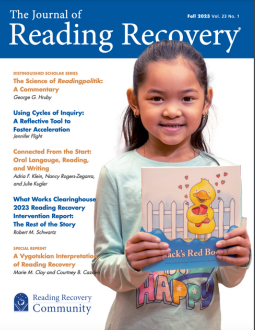Outcomes for Low Readers
Learner Outcomes for English Language Learner Low Readers in an Early Intervention
Kelly, P. R., Gómez-Bellengé, F. X., Chen, J., & Schulz, M. M. (2008). TESOL Quarterly, 42(2), 235-260.
Background
This U.S. national study compared the literacy outcomes of English language learners (ELLs) enrolled in Reading Recovery during the 2002-2003 school year with the literacy outcomes of their native English-speaking peers, also enrolled in Reading Recovery. The study also examined the relationship between initial oral English proficiency of ELLs and their success on literacy tasks and end-of-program status outcomes (whether the learner successfully completed the intervention and was at average reading and writing levels).
The study used data collected by the National Data Evaluation Center as part of the ongoing annual program evaluation. Data collected included background information, intervention status outcomes, length of intervention, fall oral English proficiency measures of ELLs, and fall and spring literacy measures. The two literacy measures examined in the study were Text Reading Level (TRL) and Hearing and Recording Sounds in Words (HRSW) from An Observation Survey of Early Literacy Achievement (Clay, 2002, 2005). The first is a measure of oral reading, while the second is an assessment of phonological awareness. These measures provide an indication of students’ abilities to read and write.
Results
Analysis showed that 76.4% of native English-speaking children (NES) and 69% of ELLs were successfully discontinued from the intervention. Results of literacy measures for children whose lessons were discontinued were similar for both ELLs and NES: The mean TRL for ELLs was 18.33; the mean for NES was 19.09. The mean HRSW for ELLs was 35.79; the mean for NES was 35.91. Program lengths for children whose lessons were discontinued were comparable: ELLs averaged 16.55 weeks, while NES averaged 15.64 weeks. Further analysis disclosed that average lengths of the intervention by fall oral proficiency levels did not differ statistically.
Analysis conducted to explore how fall oral English proficiency of discontinued ELLs related to spring literacy levels showed that ELLS with differing levels of English proficiency had comparable performance on both literacy measures at end of Reading Recovery intervention in spring. However, fall oral English proficiency levels for ELLs were related to discontinuation rates. Children with higher levels of English proficiency (Levels 4 & 5) had discontinuation rates of 71.2% and 74.7%, respectively, while children with low levels of oral proficiency (Level 1) had a discontinuation rate of 60.6%. Additionally, of the 39.4% of students who did not meet the stringent criteria for discontinuation, over 9% reached a text level of 16 or higher at the end of the year.
The authors concluded that this study confirms earlier findings that Reading Recovery is effective in accelerating the progress of the lowest-achieving first-grade children. The results support the expansion of Reading Recovery with first-grade ELLs who are having difficulty learning to read, regardless of their proficiency in English.
Resources
- Overall effectiveness
- Learning of at-risk children
- Comparing instructional models
- Helping at-risk children
- Phonological processing skills
- Experimental evaluation
- Meta-analysis of U.S. schools
- Children’s achievement
- English language learners
- Spanish-speaking children
- Bilingual student success
- Early intervention evidence
- Outcomes for low readers
- Self-esteem
- Impact on self-concepts
- Self-perceptions
- Teacher-student ratio
- Effects in RTI approaches
- Comparing instructional models
Read more about Research & Evaluation
THE JOURNAL OF READING RECOVERY
Fall 2023
The Science of Readingpolitik: A Commentary by George G. Hruby
Distinguished Scholar Series: A Vygotskian Interpretation of Reading Recovery by Marie M. Clay and Courtney B. Cazden
Using Cycles of Inquiry: A Reflective Tool to Foster Acceleration by Jennifer Flight
Connected From the Start: Oral Language, Reading, and Writing by Adria F. Klein, Nancy Rogers-Zegarra, Julie Kugler

